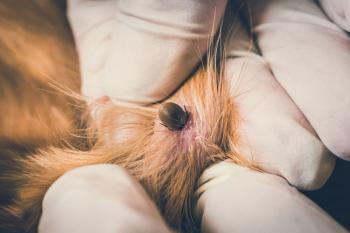
Economics of Johne's Disease (Proceedings)
Over the last 10 years we have seen a very substantial change in dairy producers' approach to Johne's disease.
Over the last 10 years we have seen a very substantial change in dairy producers' approach to Johne's disease. When the NAHMS dairy '96 survey was conducted, only 18% of producers claimed to be fairly knowledgeable about this problem. Educational efforts to inform producers about the disease have been very successful. The NAHMS dairy 2006 survey shows that 58% of producers are fairly knowledgeable. Considering producers who were either fairly knowledgeable or knew some basics of those surveys showed an improvement from 55% in 1996 to 94% in 2006. This is important progress, because the 2006 survey also showed that on the basis of environmental sampling of dairies at least 68% of US dairies are infected with MAP. This measurement is clearly an underestimate, because the environmental sampling will fail to detect some infected operations. While very few dairies were concerned about Johne's disease in 1996, by 2006 32% of dairy herds were in a control program and 35% were doing some testing.
It seems clear that many veterinarians and producers now have information and tools that can help them work effectively to combat this disease. It is not always clear how aggressively the problem should be pursued and how it ranks in comparison with other issues that producers face. There are numerous disease challenges on dairy operations, some of which have very adverse effects on the cows and are very costly to the operation. It can be difficult to determine which problems should be addressed as the highest priority and what investment of time, effort and money is the most prudent.
A critical determination has not yet been made regarding whether Johne's disease is a zoonotic problem. If it is determined that the causative agent can transfer from cattle to humans and cause Crohn's disease, then this problem warrants very serious attention in order to protect human health. On the other hand, if it does not appear that the agent harms humans, then the primary concern about this disease is its debilitating effect on cattle and resultant economic losses to the herd.
The economic impact of this disease in a herd depends greatly on the type of operation. If the owner sells animals from the herd for use as productive cattle on other operations, then the herd should be considered a seedstock operation. In this case Johne's disease is a unique liability because the purchase of new cattle is the primary means of disease introduction into herds. Alternatively, if the producer only sells commercial milk, and if that milk is not seen as a human health risk, then the primary economic impact in the herd is from decreased productivity.
Numerous studies have tried to estimate the economic losses associated with the occurrence of Johne's disease in dairy herds. Although estimates vary widely in the different studies, they are very consistent to identifying the source of economic losses. It appears that the most important loss is from decreased milk production. Reasonable estimates of production loss are that sero-test positive cows show a 10 to 15% lifetime decrease in production. Fecal test positive cows show a three to 30% production loss, with heavy shedders showing the greatest production decreases.
The other major contributors to decreased productivity of cattle with Johne's disease are from increased risk of removal from the herd and from decreased value of the animal at the time of sale. Studies that have evaluated these features have found about a 2 fold increased risk of removal from the herd, with 1 to 3 year decreased productive time in the herd. As the animals are culled, their sale value has been estimated to decrease by 30 to 40% if clinically affected, and sale weight has been estimated as reduced by about 130 lbs if fecal culture positive.
Other liabilities may be attributed to Johne's disease occurrence in a herd, such as increased incidence of other diseases, or decreased reproductive performance or altered milk components. However, these findings have typically not been repeated in other studies, and it seems unlikely that they contribute substantially to the negative effects of the disease.
It is worth noting that most of the estimates of economic losses attributable to JD have been made in dairy herds. This represents several realities about the nature of the disease in US cattle. The disease appears to be more prevalent in dairy than in beef herds, and the losses due to the disease usually don't occur until animals are mature. Therefore, sale of young calves as commercial feeders is not greatly affected by the disease in beef herds. And unless prevalence within a herd is very high, the occasional loss of mature beef cattle in commercial herds is not a major economic problem. So in commercial cow-calf herds it is hard to show significant economic loss attributable to JD. In seedstock herds, the same problems of decreased value of the stock can occur as in dairy seedstock operations.
In commercial dairy herds the economic costs associated with JD can be categorized as 'unrealized revenue' and as 'out of pocket' costs. The major costs of having the disease in the herd are the unrealized revenue that accrues from decreased productivity, decreased time in the herd and decreased salvage value. It is important to realize that these costs cannot be recouped, and they can be hard for a producer to see. Therefore, when we recommend control measures to decrease JD prevalence in the herd, we are saying that investment now of real out-of-pocket money (for testing, management time, facilities changes, etc) will presumably decrease the amount of unrealized revenue in the future. Furthermore, these investments compete to some degree with other investments the producer could make. Such alternative investments might be for control of other diseases, for improved production of the herd by another avenue, or even for expansion of facilities or cow numbers.
To see where investments in JD control are most reasonable we need to look at the whole herd and producer opportunities. Investments in control of JD that also accrue other benefits, such as facilities improvements, milk pasteurization for young calves, and calving management improvements that may substantially improve newborn calf health, become the best investments because they can derive economic value for more than one reason. Those investments that only serve to decrease JD prevalence are more troublesome, because a producer needs to determine if it is the best use of investment opportunity.
For herds with low prevalence of infection, the real losses at the present time are probably small, and typically much lower than losses associated with several other diseases, such as mastitis and lameness. For such herds, it is difficult to argue that JD control warrants more attention and investment than similar investments in control of these other problems. Clearly, the JD program in such cases needs to be a low-cost approach or it can't be justified. On the other hand, ignoring JD completely is rarely a good choice because low prevalence herds eventually become high prevalence herds, and then suffer very high economic losses, unless reasonable measures are taken to decrease spread of infection. In high prevalence herds the losses associated with JD may be one of the most significant problems the herd faces, and substantial out-of-pocket expenses may be not only justified, but critical to herd survival.
The risk assessment tools that have been developed for use by practitioners working with dairy herds are very useful in assessing the most appropriate course of action for individual herds. If these are done properly the veterinarian and the producer should be able to agree on the herd challenges that seem to be most important. Ideally, a spreadsheet with estimates of economic losses would be helpful, but even without that level of detail good evaluation of herd status and future goals can be achieved. This should be the basis for decisions on economic investments in disease control, including decisions about testing strategy, use of test results, culling, facilities modifications, and animal handling procedures.
Newsletter
From exam room tips to practice management insights, get trusted veterinary news delivered straight to your inbox—subscribe to dvm360.




